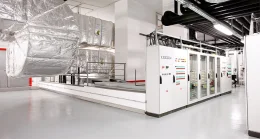The Replacement of Server Room Air Conditioners Refrigerants
From 2015, it became illegal to use Hydrochlorofluorocarbons (HCFCs), including the ozone-depleting refrigerant gas R22, in refrigeration, heat pump and air conditioning (AC) systems. R22 was commonly used in cooling systems pre-dating 2004 and its ban has had a major effect on air-conditioning costs.
R22 Refrigerant History
R22 is a hydrochlorofluorocarbon (HCFC) and greenhouse gas with a high Ozone Depleting Potential (ODP) used as a refrigerant within air conditioning systems for server rooms and datacentre, process chillers and industrial refrigerant plants.
The refrigerant was banned from being used in newly manufactured systems from 1st January 2003 and from being stocked or used for topping up existing air conditioners from 1st January 2005. These changes were driven by EU legislation (the ODS Regulation 2037/2000) to enforce The Montreal Protocol to end the supply of R22 refrigerant by 2015 due to the effect the greenhouse has on the environment and ozone layer. The ending of supply not only affected the production of new air conditioners but also the maintenance of installed air conditioning systems using R22 refrigerants.
Replacing R22 In Air Conditioners
With suppliers no longer able to stock even reclaimed R22 refrigerant what options exist for organisations running legacy-based air conditioners within server rooms and datacentres?
The first option is to look to replace the existing air conditioner systems. This has several advantages:
- A more environmentally friendly refrigerant that is compliant to current legislation such as R32
- More energy efficient systems designed to use less energy for the same kW cooling output
- New manufacturer warranty and potentially lower maintenance costs
The second option is to look to replace the R22 refrigerant with an acceptable alternative such as R410A for air conditioners and R404A and R507 for general refrigeration. For this second option to work other parts of the cooling system may require replacement for compatibility.
Cooling System Replacement or Upgrade Options
When faced with the choice about whether to replace or upgrade an existing air conditioner the following checklist can provide some useful input:
The age, operational and maintenance history of the existing air conditioner. If the system is approaching 8-10 years it may be more economical to replace. If the exiting units have a history of leaks or other related flow problems the systems should be replaced,
The efficiency of the existing air conditioner. Newer systems tend to have higher operational efficiencies and lower operational costs to run leading to a faster payback period for the capital outlay.
The availability and suitability of replacement refrigerants and manufacturer guidelines and recommendations. Replacement refrigerants can lead to poorer performance and higher energy and running costs.
Budget costs and operational windows for downtime. The financial impact of project will depend on many factors and the decision on whether to replace or not may come down to the need for operational resilience and/or downtime window opportunities.
Any organisation running air conditioners using R22 refrigerant does not have to replace them provided that they are leak free and pressurised according to manufacturer instructions.
As an approximation most R22 refrigerant-based air conditioning and refrigeration units are around half-way or more through their working life. As existing systems start to fail they can be repaired or replaced as part of a general building refit.
Where a new cooling unit is required, the project must be well planned and executed to reduce downtime and ensure a smooth transition. If the site has little or no air conditioner redundancy (N+X) in its design, then site operations will probably have to be powered down for the new installation to take place or temporary cooling systems brought in.
Energy Efficiency Considerations
Energy saving is an important consideration to take into consideration. One can guarantee that future legislation will focus on energy saving and the lowering of carbon footprint when it comes to buildings and the systems they operate.
For landlords renting out office space or colocation datacentres offering server rooms and rack cabinets, energy and operational costs are passed onto clients and could impact overall price (rental) competitiveness. Savings can increase profits or provide more competitive rates.
Moving to more energy efficient air conditioning can lower overall running costs and improve the overall efficiency rating of a building.
In the UK all air conditioners over 12kW should be inspected by a professional company employing qualified energy assessors every 5 years under The Energy Performance of Buildings Directive. The purpose of the inspection is to assess the unit’s operational efficiency and effectiveness in terms of its size and suitability to the cooling loads. The inspection is an ideal time to consider whether to replace the air conditioning units and move to a new refrigerant based system.
As an alternative refrigerant, R410A is a zero-ozone depleting refrigerant and is more energy efficient than R22. When combined with new cooling, inverter and heat pump technologies the energy efficiency increase over an existing system can be as high as 30% or more opening up the potential for tax savings through Enhanced Capital Allowances.
Enhanced Capital Allowances (ECA)
The Carbon Trust administers the UK government’s ECA scheme which is designed to provide tax incentives through a first-year write-off for organisations that install equipment listed on the Energy Technology List (ETL). To be listed the equipment must meet certain energy efficiency thresholds set for its category and of course use compliant materials: refrigerants in the case of cooling systems.
Most air conditioner manufacturers for have systems approved and listed on the ETL providing installers like Server Room Environments with potential upgrade and replacement options for their datacentre and server room clients.
End of Life Recycling
In the UK there are many sites running R22 refrigerant-based air conditioners and cooling systems. Our cooling system experts are available for consultation and advice should you need to consider either an upgrade or replacement program for your on-site cooling systems. Simply call us to arrange a free site survey or telephone consultation.
Server Room Environments provides a complete project management service including environmentally friendly disposal and recycling. Even for fixed installation air conditioner systems not covered under WEEE we can achieve up to 95% recycling of removed systems through our recycling centres.
Using R32 Refrigerant For New Server Room Air Conditioner Installations
Apart from the carbon dioxide associated with their manufacture and usage, all refrigerants have an additional environmental impact in that they contribute towards global warming. This gives rise to a specific metric referred to as Global Warming Potential (GWP) which can be hundreds or thousands times greater than their associated carbon dioxide levels. As a reference point carbon dioxide has a GWP=1.
R32 is rapidly emerging as the next best refrigerant for air conditioners as it offers advantages in terms of higher energy efficiency and lower environmental impact. This can be seen when comparing R32 to R410A:
- R410A has a GWP of 2088 with 10Kg equivalent to 20.88 t of CO²
- R32 has a GWP of 675 with 10Kg equivalent to 6.75 t of CO²
From the comparison it is evident that R32 can be up to 70% more environmentally friendly in terms of GWP and carbon dioxide than R410A. R32 therefore provides a means for the EU to meet its 2030 goal of phasing out and phasing down the usage of refrigerants with high GWP and carbon dioxide figures. A potential downside of R32 is that it is flammable and has a Class 2 (lower flammable refrigerant) under ISO 5149, ISO 817 and EN 378. R32 is however non-toxic (identified as concentrations of 400ppm or less).
The greater advantages associated with R32 mean that most air conditioner manufacturers now include R32 refrigerant based products in their portfolio and many installers now offer these as their preferred choice. R32 refrigerant-based air conditioners are more energy efficient with lower running costs and noise output than traditional cooling systems. They are also more future-proof in terms of EU legislation on refrigerant usage.


























